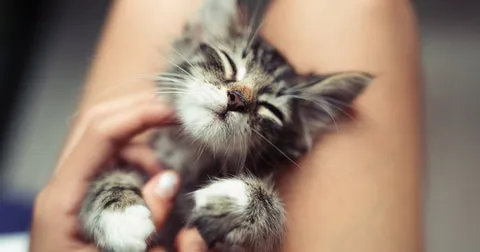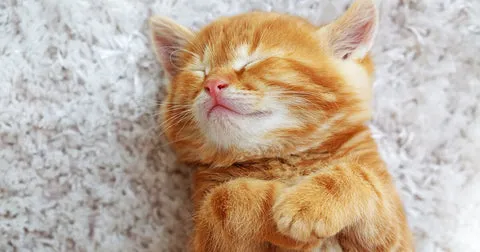Bringing a new kitten into your home is an exciting experience. However, as they grow, kittens can sometimes get carried away during play, leading to biting and scratching. Teaching your kitten proper behavior from a young age is crucial to ensure you can enjoy a happy and injury-free relationship with them as they mature. This guide will walk you through effective methods to discipline kittens for biting and scratching, focusing on positive reinforcement and redirection.
Redirect Playful Energy to Toys
Kittens are naturally playful and may instinctively grab at hands and feet, mistaking them for toys. It’s vital to teach them that only designated toys are for biting and scratching. If your kitten starts to nip or paw at you, react with a firm “no!” and immediately redirect their attention to an appropriate toy. You can also pause playtime for a few minutes to emphasize that rough play will end the fun. Consistently avoid using your hands or feet as playthings; always opt for toys, preferably those that keep a safe distance between your body and your kitten’s claws and teeth, such as feather wands, balls, or stuffed toys.
 Kitten playing with a feather wand toy.
Kitten playing with a feather wand toy.
Encourage Use of Scratching Posts
Scratching is an innate behavior for cats, essential for stretching their claws, marking territory, and releasing energy. Playful kittens often use their claws for pouncing and hunting practice. While this is normal, it’s important to redirect this behavior onto a scratching post or appropriate toys whenever their claws extend towards you. Signs that a kitten is preparing to pounce include dilated pupils, a twitching tail, and flattened ears. Ensuring each cat in your household has access to at least one scratching post, and ideally an extra one, is key to managing their scratching needs and redirecting this natural instinct away from furniture and people.
 Kitten scratching a sisal-covered post.
Kitten scratching a sisal-covered post.
Immediate Intervention for Aggression
If your kitten exhibits excessive biting or scratching, it’s important to address it immediately to discourage the behavior. When aggressive play occurs, stop all interaction and play. Remove yourself from your kitten’s reach and withhold any attention, petting, or rewards. Ignoring the unwanted behavior by calmly walking away and giving your kitten space for 5-10 minutes can effectively teach them that aggression leads to a loss of attention. Consistency is key; implementing this every time aggressive behavior occurs will help your kitten learn to associate it with negative consequences. This method is particularly effective for kittens still in their developmental learning phase and for affectionate adult cats who value your attention. Remember to remain patient and calm, as cats respond best to positive reinforcement.
Use Your Voice Effectively
Your vocalizations can be a powerful tool in communicating your displeasure. When your kitten nips, use a sharp, clear “no!” or “ouch!” command. This vocal cue, combined with ignoring the behavior, reinforces that you are not happy with their actions. However, avoid shouting, as this can make your kitten fearful or anxious, potentially worsening the behavior. Maintain a calm tone and never lose your temper. After a brief cooling-off period, you can resume play, using your voice to reward calm behavior and gently discourage overexcitement. Always reinforce positive actions and cease play when your kitten becomes too rough.
 A group of cute kittens interacting.
A group of cute kittens interacting.
Establish Daily Play Routines
Consistent daily play sessions, ideally 10-15 minutes twice or thrice a day, are crucial for a kitten’s well-being. These routines help them bond with you, feel secure, and expend excess energy, thereby reducing the likelihood of aggressive behaviors. Teaching your kitten to play gently is an integral part of your relationship. By consistently reinforcing good play habits and redirecting or ignoring unwanted behaviors, your kitten will learn to interact appropriately.
Avoid Rewarding Unwanted Behaviors
It might be tempting to continue petting or playing with your kitten after they bite or scratch, but this can inadvertently reinforce the behavior. Your attention, even if negative, can be perceived as a reward, potentially leading your kitten to repeat these actions to gain more attention. Always disengage immediately and ignore your kitten when unwanted biting or scratching occurs.
 A kitten looking healthy and alert.
A kitten looking healthy and alert.
Rule Out Health Issues
Persistent or unusual aggression in your kitten could signal an underlying health problem. If biting or scratching continues despite your training efforts, consult your veterinarian to rule out any pain or illness that might be causing your cat to feel defensive or act aggressively.
Foster a Calm Environment
A stressed or anxious kitten is more prone to biting and scratching. Ensure your kitten’s environment is conducive to calmness. This includes providing adequate resources such as hiding spots, food and water stations, litter boxes, and scratching posts. Maintaining a consistent routine for feeding and playtimes can also help. Minimize sudden loud noises or significant changes in the household. Consider using a feline pheromone diffuser, such as the FELIWAY Optimum diffuser, in the areas where your cat spends the most time. These diffusers can help promote a sense of calm and are recommended for reducing behaviors like scratching, spraying, and hiding.
 A content and relaxed kitten resting.
A content and relaxed kitten resting.
By implementing these strategies consistently and patiently, you can effectively discipline your kitten for biting and scratching, fostering a harmonious and loving relationship for years to come.
